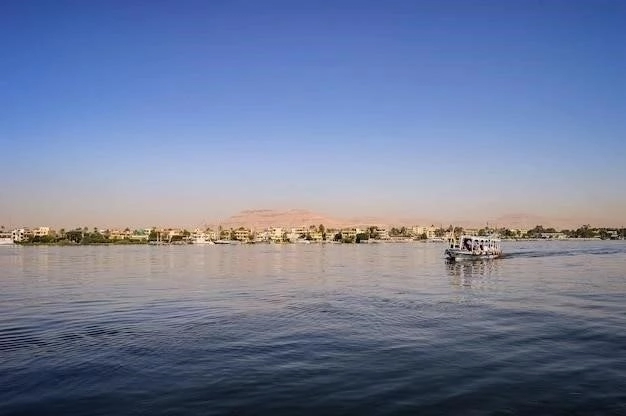The Nile River, a majestic and historically significant waterway, holds the distinction of being one of the longest rivers in the world. Its course, stretching over 6,650 kilometers (4,132 miles), traverses eleven countries in northeastern Africa, making it a vital lifeline for millions of people.
Origin and Tributaries
The Niles journey begins in the heart of Africa, with its most distant source being the Kagera River in Burundi. This tributary flows into Lake Victoria, the largest lake in Africa, which also receives water from other rivers. From Lake Victoria, the White Nile emerges, flowing northward through Uganda, South Sudan, and Sudan.
In Ethiopia, the Blue Nile originates from Lake Tana. It carries a significant amount of silt, giving the Nile its characteristic brown color during the flood season. The Blue Nile joins the White Nile in Khartoum, Sudan, forming the main Nile River.

The Course of the Nile
From Khartoum, the Nile flows northward through Sudan and Egypt. It is joined by the Atbara River, its last major tributary, before entering Egypt. As the Nile approaches the Mediterranean Sea, it forms a delta, a fertile region with numerous branches and distributaries.
The Nile Delta is a densely populated area with a long history of agriculture. It is home to major cities like Cairo, Alexandria, and Port Said.
Historical Significance
The Nile River has played a pivotal role in the development of human civilization. Ancient Egypt, one of the worlds earliest civilizations, flourished on the banks of the Nile. The river provided fertile land for agriculture, water for irrigation, and a means of transportation.
The annual flooding of the Nile was a vital event for the ancient Egyptians. The floods deposited nutrient-rich silt on the land, ensuring agricultural productivity. The ancient Egyptians developed sophisticated irrigation systems and a calendar based on the Niles flood cycle.
Modern Significance
Today, the Nile River remains a vital resource for the countries it traverses. It provides water for irrigation, drinking, and industrial use. The Aswan High Dam, completed in 1970, regulates the Niles flow, preventing floods and generating hydroelectric power.
The Nile is also a major transportation route, connecting cities and towns along its course. Tourism is another important industry, with visitors drawn to the rivers historical sites, wildlife, and scenic beauty.
Environmental Challenges
The Nile River faces a number of environmental challenges, including pollution, overfishing, and habitat loss. Rapid population growth and industrial development are putting increasing pressure on the rivers resources.
Climate change is also a concern, with potential impacts on rainfall patterns and water availability. International cooperation is crucial to address these challenges and ensure the sustainable management of the Nile River.
Conclusion
The Nile River, with its immense length, historical significance, and modern importance, is a testament to the power of nature to shape human civilization. Its waters have sustained life, inspired art and culture, and continue to play a vital role in the lives of millions of people. As we move forward, it is essential that we protect and preserve this precious resource for generations to come.

Ecological Significance and Biodiversity
Beyond its human impact, the Nile River system serves as a critical ecological corridor, supporting a diverse range of flora and fauna. The rivers floodplain, with its seasonal inundations, creates a unique ecosystem known as a “pulse system”. This natural cycle of flooding and recession supports a high level of biodiversity by providing nutrients and creating a mosaic of habitats.
The Niles “Pulse System” and its Importance
The annual flood cycle of the Nile, historically predictable, played a crucial role in shaping the ecosystem. This “pulse system” refers to the regular inundation of the floodplain followed by a gradual recession. This natural process brought several benefits:
- Nutrient Replenishment: Floodwaters carried nutrient-rich silt from the Ethiopian highlands, replenishing the floodplains fertility and supporting agriculture.
- Habitat Creation: The receding floodwaters created a variety of habitats, from temporary wetlands and pools to grasslands, supporting a wide array of species.
- Fish Spawning: Many fish species relied on the flood cycle for spawning, with the inundated floodplain providing ideal breeding grounds.

Flora and Fauna of the Nile
The Nile River and its associated wetlands are home to a rich variety of plant and animal life. Some notable species include:
- Fish: The Nile perch, tilapia, and catfish are some of the prominent fish species found in the river. The Nile perch, while economically important, has had significant ecological impacts as an introduced species.
- Birds: The Nile is a vital stopover point for migratory birds and supports resident species like herons, egrets, and the iconic African fish eagle.
- Mammals: While populations have declined, the Nile is home to hippopotamuses, African softshell turtles, and the Nile crocodile, a keystone predator in the ecosystem.
- Vegetation: Papyrus reeds, water hyacinths, and acacia trees are some of the plant species found along the Niles banks and in its wetlands.
Threats to the Niles Ecosystem
The Nile Rivers ecosystem faces increasing pressure from human activities and development. Some major threats include:
- Dams and Water Regulation: While crucial for water management, dams like the Aswan High Dam have altered the natural flood cycle, impacting floodplain ecosystems and fish populations.
- Pollution: Agricultural runoff, industrial discharge, and sewage pollution threaten water quality and harm aquatic life.
- Habitat Loss and Degradation: Conversion of wetlands for agriculture, urbanization, and deforestation along the riverbanks are leading to habitat loss and fragmentation.
- Climate Change: Altered rainfall patterns and increasing temperatures threaten to exacerbate existing pressures on the Niles ecosystem.

Conservation Efforts and the Future
Recognizing the ecological importance of the Nile River, conservation efforts are underway to address the threats and promote sustainable management. These include:
- Transboundary Cooperation: Given the Niles transboundary nature, cooperation among riparian countries is crucial for effective conservation strategies.
- Integrated Water Resource Management: Balancing the needs of human populations with the requirements of the ecosystem is essential for long-term sustainability.
- Pollution Control: Implementing stricter regulations on industrial discharge, wastewater treatment, and agricultural practices is crucial to improve water quality.
- Protected Areas: Establishing and managing protected areas along the Nile River and its wetlands can help conserve biodiversity and critical habitats.
The future of the Nile Rivers ecosystem hinges on our collective commitment to sustainable practices and conservation efforts. By addressing the challenges and working together, we can ensure the health and resilience of this vital ecosystem for generations to come.










